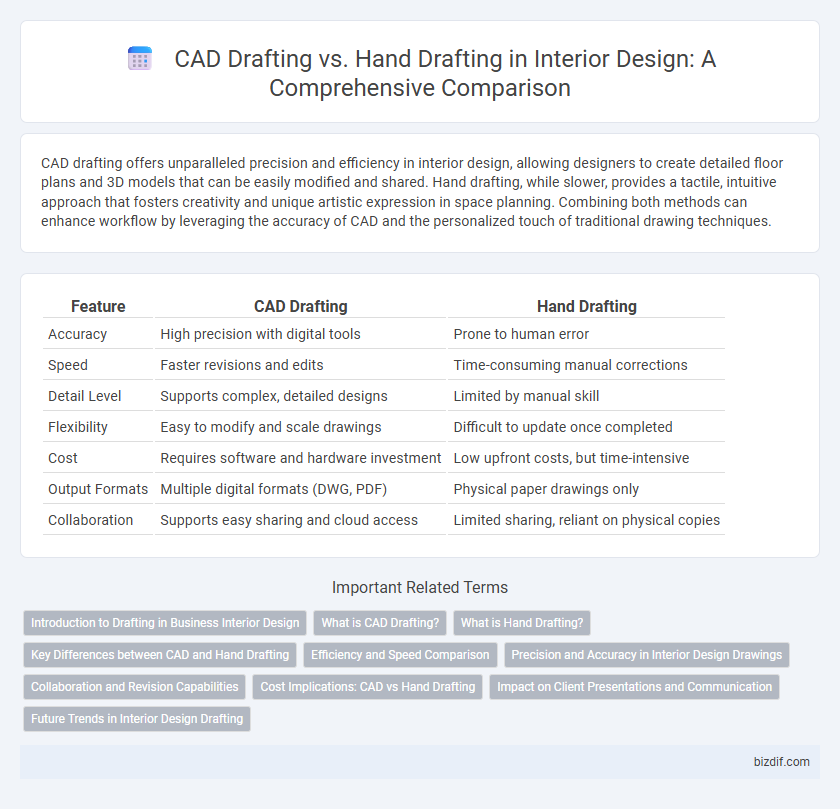CAD drafting offers unparalleled precision and efficiency in interior design, allowing designers to create detailed floor plans and 3D models that can be easily modified and shared. Hand drafting, while slower, provides a tactile, intuitive approach that fosters creativity and unique artistic expression in space planning. Combining both methods can enhance workflow by leveraging the accuracy of CAD and the personalized touch of traditional drawing techniques.
Table of Comparison
| Feature | CAD Drafting | Hand Drafting |
|---|---|---|
| Accuracy | High precision with digital tools | Prone to human error |
| Speed | Faster revisions and edits | Time-consuming manual corrections |
| Detail Level | Supports complex, detailed designs | Limited by manual skill |
| Flexibility | Easy to modify and scale drawings | Difficult to update once completed |
| Cost | Requires software and hardware investment | Low upfront costs, but time-intensive |
| Output Formats | Multiple digital formats (DWG, PDF) | Physical paper drawings only |
| Collaboration | Supports easy sharing and cloud access | Limited sharing, reliant on physical copies |
Introduction to Drafting in Business Interior Design
CAD drafting transforms business interior design by offering precise, scalable, and easily modifiable digital blueprints that enhance communication among architects, designers, and contractors. Hand drafting, although valued for its artistic touch and foundational skill development, lacks the efficiency and accuracy required in fast-paced commercial projects. Integrating CAD in drafting processes accelerates project timelines and improves spatial planning accuracy, crucial for optimizing workplace functionality and aesthetics.
What is CAD Drafting?
CAD drafting involves using computer-aided design software to create precise and detailed interior design plans, enabling efficient modifications and accurate measurements. This technology supports 2D and 3D modeling, enhancing visualization and spatial planning for interior spaces. CAD drafting improves workflow productivity and reduces errors compared to traditional hand drafting methods.
What is Hand Drafting?
Hand drafting in interior design involves creating detailed sketches and technical drawings manually using tools like pencils, rulers, and compasses. This traditional method allows designers to quickly capture concepts and make adjustments on paper, fostering creativity through tactile interaction. Although less common than CAD drafting, hand drafting remains valuable for its direct, intuitive approach to spatial planning and design communication.
Key Differences between CAD and Hand Drafting
CAD drafting offers precision, efficiency, and easy modifications through digital tools, enabling designers to create detailed interior plans with exact measurements and layering options. Hand drafting, while more time-consuming and less flexible, provides a tactile connection to the design process, allowing for creative expression and a unique, personalized touch. The key differences lie in accuracy, speed, and the ability to easily edit designs, with CAD becoming the industry standard for professional interior design drafting.
Efficiency and Speed Comparison
CAD drafting significantly outperforms hand drafting in efficiency and speed by enabling rapid modifications and precise measurements through advanced software tools, reducing project turnaround times. Automated features such as layering, scaling, and replication streamline complex design processes, minimizing human error and manual labor. Hand drafting, while offering a tactile and creative approach, is considerably slower and less adaptable for large-scale or iterative interior design projects.
Precision and Accuracy in Interior Design Drawings
CAD drafting offers significantly higher precision and accuracy in interior design drawings compared to hand drafting, enabling exact measurements and detailed layouts that minimize errors. Digital tools allow for easy modifications and scaling, ensuring consistent and clear representations of spatial dimensions, furniture placement, and material specifications. This enhanced accuracy streamlines communication with clients and contractors, reducing misunderstandings and costly revisions during the project implementation.
Collaboration and Revision Capabilities
CAD drafting streamlines collaboration by enabling multiple team members to work simultaneously on digital blueprints, with real-time updates and easy sharing across platforms. It offers superior revision capabilities through precise editing tools, version control, and instant error detection, reducing time and minimizing miscommunication. Hand drafting, while allowing for personalized artistic input, lacks efficient collaborative features and makes tracking revisions cumbersome and prone to mistakes.
Cost Implications: CAD vs Hand Drafting
CAD drafting significantly reduces labor costs by enabling faster revisions and precise measurements, minimizing errors and material waste in interior design projects. Hand drafting, while less expensive in terms of initial tools, often incurs higher cumulative costs due to longer project timelines and the potential need for redrawing. Investing in CAD technology ultimately streamlines workflows and offers long-term savings by improving accuracy and efficiency in design documentation.
Impact on Client Presentations and Communication
CAD drafting enhances client presentations by providing precise, editable, and 3D visualizations that clearly communicate design intent and spatial relationships. Hand drafting offers a personalized, artistic touch that can convey design concepts through sketches, fostering a more emotional connection with clients. Combining both methods improves overall communication by balancing technical accuracy and creative expression in interior design projects.
Future Trends in Interior Design Drafting
Future trends in interior design drafting emphasize the increasing integration of CAD drafting due to its precision, efficiency, and compatibility with 3D modeling and virtual reality tools. Hand drafting, while valued for its artistic expression, is gradually becoming a supplementary skill as automation and AI-driven design software enhance project customization and client collaboration. The evolution towards digital platforms supports sustainable practices by reducing paper use and improving real-time design modifications.
CAD drafting vs hand drafting Infographic

 bizdif.com
bizdif.com